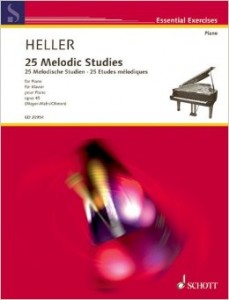Heller’s “L’avalanche, Op. 45, No. 2” Piano Play-Along: Post Three (Edition Comparison)
 Thanks to all of you who held in there despite some setbacks in the Play Along schedule so far. I hope you all enjoyed “getting in shape” with the Heller L’avalanche as much as I did. I haven’t taught the piece in a while and think it’s time I insert it again into my curriculum. Matter of fact, I have a young boy learning it this summer. He was quite attracted to how it scampers about and he said it would be great for Halloween. Hadn’t thought of that, but it would. I find that many students are attracted to pieces in minor keys. Have you noticed that as well?
Thanks to all of you who held in there despite some setbacks in the Play Along schedule so far. I hope you all enjoyed “getting in shape” with the Heller L’avalanche as much as I did. I haven’t taught the piece in a while and think it’s time I insert it again into my curriculum. Matter of fact, I have a young boy learning it this summer. He was quite attracted to how it scampers about and he said it would be great for Halloween. Hadn’t thought of that, but it would. I find that many students are attracted to pieces in minor keys. Have you noticed that as well?
Anyway, as promised, I will dispel some of the mysteries in the various editions of “L’avalanche” with this post. I am taking the Schott edition below (which is probably the most authoritative edition available; no urtext was found) and will perform a little cross-comparison with 4 other student editions on my desk.
You might want to pull out your copy as you read this and make a few notes. I think it’s easier for me to list inconsistencies measure by measure, according to a particular aspect. Most of the editions had inconsistencies in pedaling and dynamic (accents mostly).
_____________________________________________________________________
Accents:
First, some editions did not include both rooftop and regular accents (horizontal). The Schott edition differentiates between the two.
mm.1 -12: Only the half notes have accents (rooftop). The same is true for similar sections.
mm. 34 and 36 (50 and 52): There are rooftop accents on the downbeats of these measures.
m. 56: There is an accent on this downbeat, but it is a regular accent this time around, not a rooftop like before. Found this odd, but I did see it in a couple of other editions as well.
mm. 57 – 59: There are no accents at all on the downbeats here.
mm. 69 and 71: Though these are forte, they are not accented.
m. 75: A regular accent on the downbeat of the RH
m. 77: RH has no accent here (probably due to the subito P)
Pedal:
mm. 1 – 8: There is pedaling on the half notes with a release on beat 2.
mm. 10 and 12: Strangely, there was no pedaling indicated for these half notes which made me curious. Mistaken omission? I might pedal as in mm. 1- 8. 3 of the 4 editions added the pedal.
mm.13-14: This is indicated to be played portato without pedal. Almost all editions added pedal here. If I added pedal, it would only be a speck. For sure I’d want to keep the chords from blurring together.
mm. 34-36 (and similar sections): This section has no pedaling indicated, though many editions added a pedal for each chord of the RH. I would probably add it for warmth and assistance with the cresc.
mm. 44 – 46: No pedaling is indicated here, but most editions added it probably so it would match the indicated pedaling in m. 47.
mm. 69 and 71: There is definitely pedaling indicated for each of the two chords here.
mm. 85 – 89: Believe it or not, these last few measures should be held under one long pedal. Some editions did include it and some removed the pedal indication entirely. It’s a 19th century thing. I’d do it.
Dynamics:
m. 43: No dim. here!
m. 83: There is indeed a subito P on the downbeat.
m. 84: most editions used 8va here for the RH, though I found one that didn’t. Yikes. Lots of ledger lines…..
Other:
mm. 13 -16 and similar: It’s poco meno mosso and not rit.
m. 82: One of my editions included this measure on the final system. Sure made it easier to read the upcoming LH quarter-note entrance on “A.” Other editions weren’t so friendly. 🙂
_____________________________________________________________________
Hope this revelation into the Schott edition helped. Will be in touch soon regarding our next summer Piano Play-Along topic. I’m away from July 2-16 presenting at teacher conferences and workshops. I’ll post where I’ll be and if I’m in your neck of the woods, stop by and stay “hi.” I’d love to meet you!










